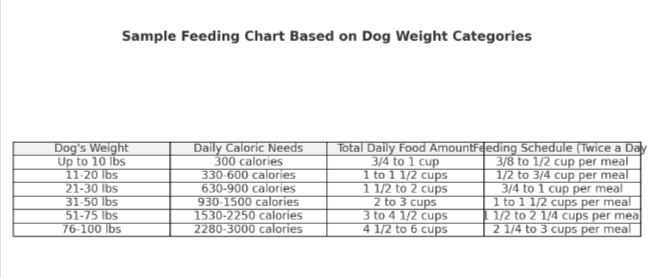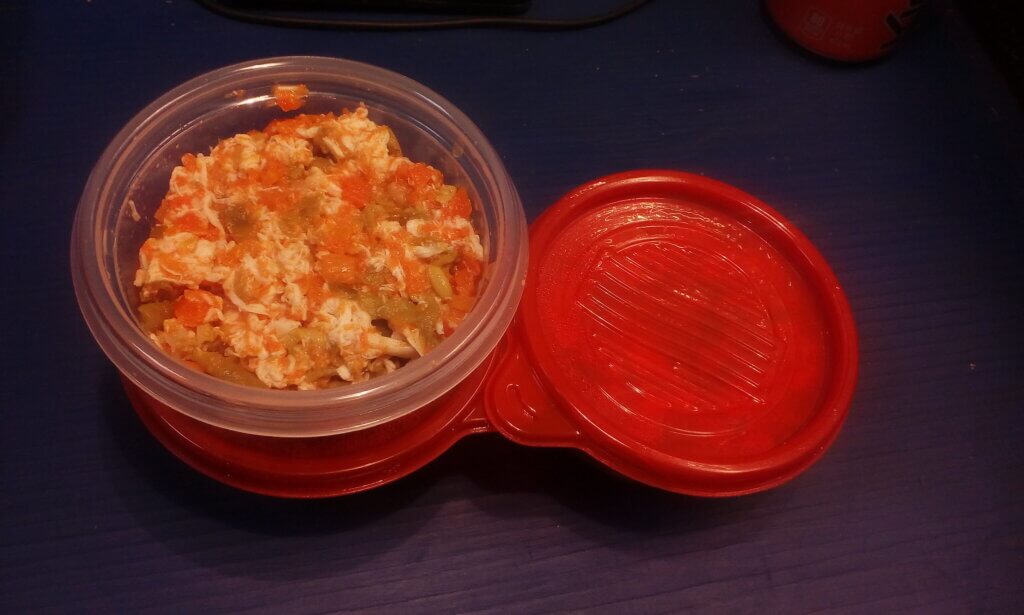How Much Homemade Dog Food to Feed
A balanced diet is essential for your dog’s general health and well-being. With more pet owners deciding to switch from commercial to homemade dog food as a better solution, understanding how much dog food to feed is essential. Homemade dog food can offer numerous benefits, including better ingredient control and fewer preservatives, but it also requires careful planning to ensure a balanced diet.
Feeding your dog the right amount of homemade food is crucial. Underfeeding can result in malnutrition, while overfeeding can cause obesity and accompanying health problems. This blog will guide you through how much homemade dog food to feed your dog daily, tailored by weight and individual needs. We’ll discuss the importance of balanced nutrition, provide detailed feeding calculations, and offer practical tips to help you maintain your dog’s optimal health. By the end of this blog, you’ll clearly understand how much homemade dog food is to feed your furry friend, ensuring they stay happy, healthy, and full of life.
Understanding Dog Nutrition

For your dog’s general health, ensure they eat a balanced, nutrient-rich diet. When preparing homemade dog food, it’s important to understand the key nutrients your dog needs and how to balance them properly. Here’s a detailed look at dog nutrition and the essential elements to consider.
Essential Nutrients in Homemade Dog Food
Proteins
- Role in Diet: Proteins are vital for muscle growth, tissue repair, and immune function. They supply the building blocks, or amino acids, required for various bodily processes.
- Sources: Good protein sources include chicken, beef, turkey, fish, eggs, and lamb. To guarantee your dog receives a range of amino acids, combine a few different types of proteins.
Fats
- Role in Diet: Fats are a major source of energy for dogs. Additionally, they enhance the absorption of fat-soluble vitamins (A, D, E, and K) and support healthy skin and coat.
- Sources: Healthy fats can be obtained from fish oil, chicken fat, flaxseed oil, and coconut oil. Including these in moderate amounts helps maintain your dog’s energy levels and overall health.
Carbohydrates
- Role in Diet: Carbohydrates provide energy and fibre, aiding in digestion. They are unnecessary, but they can be helpful, particularly for active dogs.
- Sources: Include grains like rice, oats, and barley, as well as veggies like carrots, peas, and sweet potatoes. These sources offer vital nutrients and energy.
Vitamins and Minerals
- Role in Diet: Vitamins and minerals are vital for several body processes, such as the immune system, bone health support, and metabolic processes.
- Sources: Include a range of fruits and veggies, such as spinach, blueberries, and carrots, to provide these micronutrients. Supplements may sometimes be necessary to ensure your dog receives adequate amounts.
Balancing Homemade Dog Food
Importance of a Balanced Diet
- Nutrient Balance: A balanced diet ensures your dog obtains the appropriate ratios of carbohydrates, proteins, lipids, and vitamins and minerals. This balance supports their overall health, energy levels, and longevity.
- Health Benefits: Proper nutrition can prevent health issues such as obesity, diabetes, heart disease, and deficiencies. It also promotes a healthy coat, strong bones, and a robust immune system.
Common Mistakes in Homemade Dog Food Preparation
- Over-relying on Certain Ingredients: Relying too heavily on one protein or carbohydrate type can lead to nutrient imbalances. Maintaining a well-rounded diet requires variety.
- Lack of Supplements: Homemade diets might lack certain essential nutrients in commercial dog food. Supplementing with vitamins and minerals is often necessary to fill these gaps.
- Improper Portion Sizes: Not calculating the correct portion sizes can lead to overfeeding or underfeeding. It is crucial to know how much homemade dog food your dog should feed according to its exercise level, age, and weight level.
How Much Homemade Dog Food to Feed Per Day: Detailed Guide

Determining the proper amount of homemade dog food to give your dog daily is essential to keeping them healthy and avoiding problems like malnourishment or obesity. Here’s a detailed look at the guidelines you should follow to ensure your dog gets the right amount of food.
Explanation of Daily Caloric Needs
To determine how much homemade dog food to feed your dog, you need to consider their daily caloric needs, which are influenced by several factors:
- Weight: Generally, dogs require roughly 30 calories per day per pound of body weight. For example, a 50-pound dog needs approximately 1,500 calories daily.
- Age: Puppies and young dogs are more active and may require more calories than older dogs. Senior dogs, on the other hand, often need fewer calories.
- Activity Level: Active dogs require more calories to maintain their energy levels compared to less active dogs. For instance, a highly active dog might need up to 50 calories per pound of body weight.
- Health Condition: Dogs with certain medical conditions may have different dietary needs. For example, dogs with hypothyroidism might require fewer calories, while those with high energy needs might need more.
Feeding Schedules
Recommended Feeding Frequency
Once you have an idea of how much homemade dog food to feed, setting a consistent feeding schedule is crucial. Here are some guidelines for feeding frequency:
- Puppies: Puppies typically need to eat three to four times a day to support their rapid growth and energy needs.
- Adult Dogs: Most adult dogs do well with two meals per day. This helps regulate their metabolism and keeps their energy levels stable.
- Senior Dogs: Depending on their health and activity level, senior dogs might do well with one or two meals per day. Smaller, more frequent meals can sometimes be easier on their digestive system.
Sample Feeding Schedule:
- Morning: 1/2 to 1 cup of homemade food
- Evening: half to a cup of homemade food
Modify the servings depending on your dog’s weight, age, and activity level. Remember to monitor your dog’s weight regularly and adjust the food quantity if it starts gaining or losing weight unexpectedly.
By understanding the general guidelines and considering the specific needs of your dog, you can determine how much homemade dog food to feed them each day. This will help keep them healthy, happy, and full of energy. Whenever possible, work with your veterinarian to customize the diet. To your dog’s individual needs and to ensure they are receiving the appropriate nutrition.
How Much Homemade Food to Feed Dog by Weight
Determining how much homemade dog food to feed your dog involves careful calculations based on their weight. Here’s a detailed guide to help you understand how to calculate the right amount and use feeding charts effectively.
Calculating the Right Amount
Detailed Formula for Calculating the Amount of Food Based on the Dog’s Weight To determine how much of your dog’s homemade food should be fed, you need to calculate their daily caloric needs. A general guideline is that dogs require about 30 calories a day for every pound of body weight.
Formula: Daily Caloric Needs=Dog’s Weight (lbs)×30\text{Daily Caloric Needs} = \text{Dog’s Weight (lbs)} \times 30Daily Caloric Needs= Dog’s Weight (lbs)×30
Example Calculations for Different Dog Weights:
- 10-pound dog: 10 lbs×30=300 calories per day10 \text{ lbs} \times 30 = 300 \text{ calories per day}10 lbs×30=300 calories per day
- 25-pound dog: 25 lbs×30=750 calories per day25 \text{ lbs} \times 30 = 750 \text{ calories per day}25 lbs×30=750 calories per day
- 50-pound dog: 50 lbs×30=1500 calories per day50 \text{ lbs} \times 30 = 1500 \text{ calories per day}50 lbs×30=1500 calories per day
- 75-pound dog: 75 lbs×30=2250 calories per day75 \text{ lbs} \times 30 = 2250 \text{ calories per day}75 lbs×30=2250 calories per day
These calculations provide a baseline for how many calories your dog needs each day. You can then determine the amount of homemade food to provide based on the caloric content of the food.
Using a Feeding Chart
Introduction to Feeding Charts and How to Use Them Feeding charts are helpful tools that simplify determining how much homemade dog food to feed your dog. These charts typically categorize dogs by weight and provide recommended food amounts.

How to Use the Feeding Chart:
- Identify Your Dog’s Weight Category: Find your dog’s weight in the leftmost column.
- Check the Daily Caloric Needs: The second column lists the caloric needs specific to your dog’s weight.
- Determine the Total Daily Food Amount: Use the third column to find the total amount of homemade dog food your dog needs each day.
- Divide into Meals: Follow the recommended feeding schedule in the fourth column to split the daily food amount into two meals.
By using these calculations and feeding charts, you can easily determine how much homemade dog food to feed your dog, ensuring they receive the appropriate nutrition to stay healthy and active. Always monitor your dog’s weight and adjust their food portions as needed, and See a vet to customize the diet for your dog’s unique requirements.
Recipes and Meal Plans

Creating homemade dog food can be both rewarding and beneficial for your dog’s health. To help you get started, here are some sample recipes and tips on creating meal plans. This guide will help you understand how much homemade dog food to feed and ensure your dog gets a balanced diet.
Sample Recipes for Homemade Dog Food
Nutrient-Rich Recipes
- Chicken and Rice Delight
- Ingredients:
- 1 cup cooked chicken (shredded)
- 1/2 cup cooked brown rice
- 1/2 cup cooked peas and carrots
- One tablespoon of fish oil (for healthy fats)
- Instructions: Mix all ingredients thoroughly. This recipe has a healthy ratio of protein, carbs, and fats.
- Ingredients:
- Beef and Sweet Potato Mix
- Ingredients:
- 1 cup ground beef (cooked)
- 1/2 cup mashed sweet potatoes
- 1/2 cup cooked green beans
- One tablespoon flaxseed oil (for omega-3 fatty acids)
- Instructions: Combine all ingredients. This dish is high in vital nutrients and protein.
- Ingredients:
- Fish and Veggie Medley
- Ingredients:
- 1 cup cooked salmon (flaked)
- 1/2 cup quinoa (cooked)
- 1/2 cup chopped spinach
- 1/2 cup grated carrots
- Instructions: Mix all ingredients well. This dish provides essential vitamins and minerals.
- Ingredients:
How to Ensure Variety in Your Dog’s Diet
- Rotate Proteins: Use different protein sources like chicken, beef, turkey, and fish to provide a variety of amino acids.
- Include Different Vegetables: Mix up the vegetables to include options like peas, carrots, spinach, and green beans.
- Add Healthy Fats: Incorporate various sources of omega-3 fats, including coconut oil, flaxseed oil, and fish oil, to ensure balanced nutrition.
Creating a Weekly Meal Plan
Example Meal Plans for Different Weight Categories
Small Dogs (up to 20 lbs)
- Monday – Friday:
- Morning: 1/4 cup Chicken and Rice Delight
- Evening: 1/4 cup Beef and Sweet Potato Mix
- Saturday – Sunday:
- Morning: 1/4 cup Fish and Veggie Medley
- Evening: 1/4 cup Chicken and Rice Delight
Medium Dogs (21-50 lbs)
- Monday – Friday:
- Morning: 1/2 cup Chicken and Rice Delight
- Evening: 1/2 cup Beef and Sweet Potato Mix
- Saturday – Sunday:
- Morning: 1/2 cup Fish and Veggie Medley
- Evening: 1/2 cup Chicken and Rice Delight
Large Dogs (51-100 lbs)
- Monday – Friday:
- Morning: 1 cup Chicken and Rice Delight
- Evening: 1 cup Beef and Sweet Potato Mix
- Saturday – Sunday:
- Morning: 1 cup Fish and Veggie Medley
- Evening: 1 cup Chicken and Rice Delight
Tips for Meal Prepping and Storing Homemade Dog Food
- Batch Cooking: Prepare large batches of each recipe and portion them out into daily servings.
- Storage: Store the portions in airtight containers or freezer-safe bags. Homemade dog food can be kept in the refrigerator for up to three days or frozen for up to three months.
- Labeling: Label each container with the date and contents to keep track of freshness and variety.
- Defrosting: For frozen portions, defrost in the refrigerator overnight before feeding.
By following these recipes and meal plans, you can ensure how much homemade dog food to feed your dog while providing them with a balanced and varied diet. This will support the happiness and wellness of your dog and make mealtimes a breeze. Always consult with your veterinarian to tailor the meal plans to your dog’s specific needs.
Conclusion
In conclusion, it’s crucial to understand how much homemade dog food to feed your pet to ensure their health and well-being. Here’s a recap of why this is important:
The importance of feeding the right amount of homemade dog food is summarized below: Feeding your dog the right amount ensures they dog gets the nutrients it needs without overeating, which can lead to obesity and other health issues.
Encouragement to monitor and adjust feeding based on the dog’s needs: Every dog is unique. Thus, it is critical to keep an eye on its weight and modify its diet and portions accordingly. This helps maintain its ideal body condition and overall health.
Final tips for maintaining a balanced diet for your dog:
- Consistency is key: Maintain a consistent eating schedule.
- Quality ingredients: Use fresh and balanced ingredients in your homemade dog food recipes.
- Consult a vet: Regular check-ups can help ensure your dog’s nutritional needs are being met.
By following these guidelines on how much homemade dog food to feed, you can help your dog live a healthy and happy life.
how much homemade dog food to feed: FAQs
-
What factors should I consider when determining how much homemade dog food to feed?
Answer: Consider your dog’s age, size, activity level, metabolism, and any health conditions. These factors help determine the appropriate portion size to maintain optimal health.
-
How can I tell if I’m feeding my dog the right amount of homemade dog food?
Answer: Monitor your dog’s weight, energy levels, and overall condition. Adjust portion sizes accordingly to ensure they maintain a healthy weight without becoming underweight or overweight.
-
Is it possible to overfeed my dog with homemade dog food?
- Answer: Indeed, overeating can result in weight gain and potential health issues. Follow recommended portion guidelines based on your dog’s caloric needs and adjust as necessary.
- Can I use a feeding chart or calculator to determine how much homemade dog food my dog needs?
- Answer: Yes, there are online tools and feeding charts that can provide a starting point based on your dog’s weight and activity level. However, monitor your dog’s response and adjust feeding amounts based on their individual needs.
-
Should I consult a veterinarian for guidance on how much homemade dog food to feed?
- Answer: Consulting a vet is advisable to tailor a feeding plan specific to your dog’s nutritional requirements. They can also offer guidance on serving sizes, ingredient choices, and any necessary dietary adjustments based on your dog’s health.

